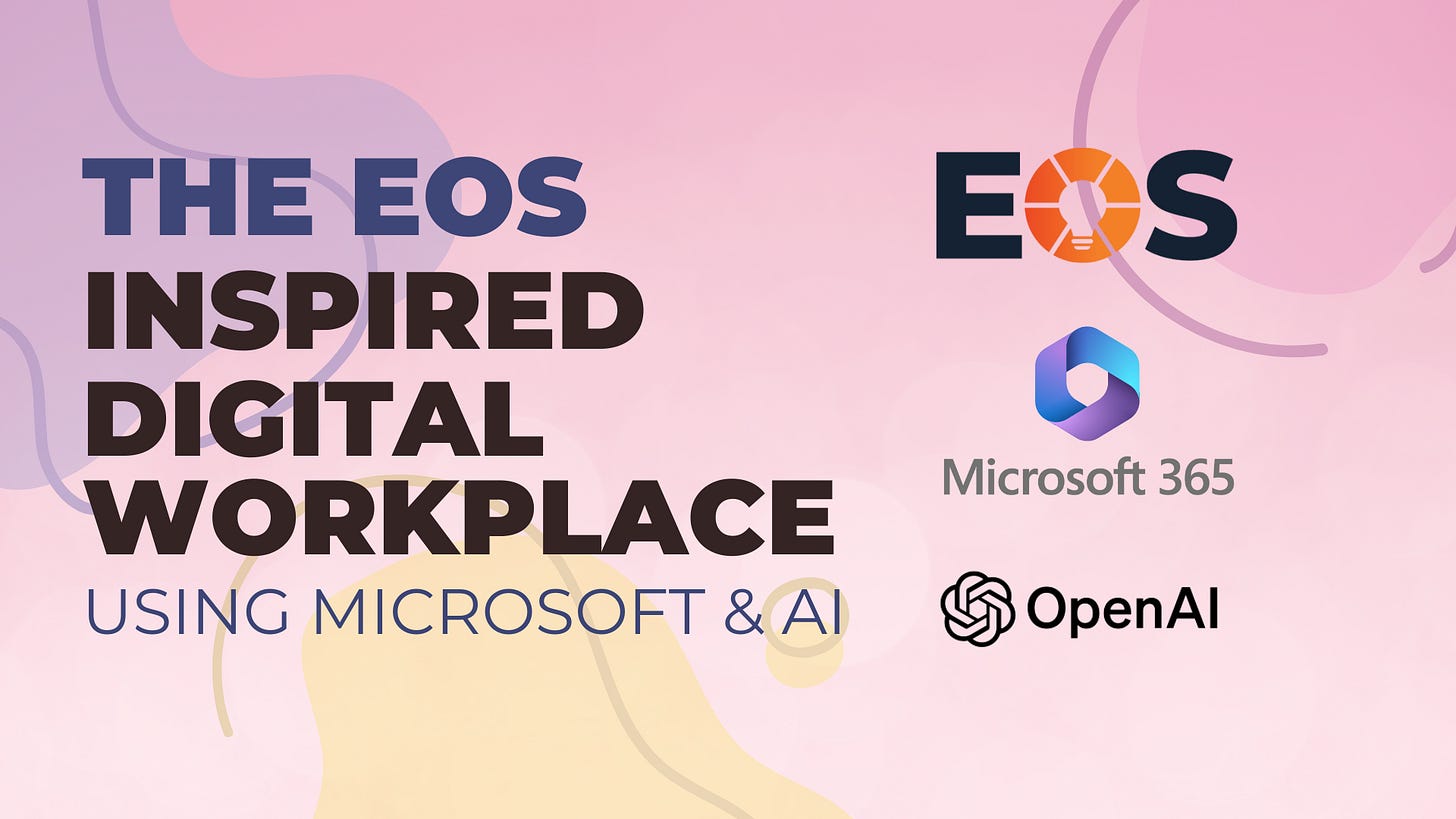The EOS inspired Digital Workplace Strategy for Businesses Using Microsoft 365
Using AI and Microsoft Cloud to make the Entrepreneurial Operating System work better for your organization.
Originally published on StitchDX
The Entrepreneurial Operating System (EOS) is a business management framework developed by Gino Wickman, first introduced in his 2006 book Traction. It is designed to help small and mid-sized businesses achieve sustainable growth by providing practical tools and processes to improve vision, accountability, and execution across leadership teams. Organizations (including us here at StitchDX, and several of our clients too) use EOS to streamline operations, improve team collaboration, and drive growth.
A modern digital workplace strategy creates a foundation for growth by aligning people, processes, and technology. Where teams are empowered to execute the company vision effectively. Where employees engage in daily collaborative processes and rituals. Where teams connect and communicate. Where projects are delivered — and your company’s mission is ultimately fulfilled.
The digital workplace is where the ‘rubber meets the road’ for EOS businesses.
Together, a thoughtful digital workplace and the EOS framework enable organizations to not just execute — but actively embody and live organizational success.
Enhancing EOS Using Microsoft 365
A well-executed digital workplace strategy complements the EOS framework by enhancing the core elements that EOS emphasizes—vision, accountability, communication, and execution.
Clarity of Vision: EOS helps businesses define their vision, and a digital workplace strategy, with tools like SharePoint and Microsoft Teams, can centralize and easily disseminate this vision across the organization. Everyone can access the same information from a ‘single source of truth’, ensuring alignment and transparency.
Accountability Through Data: EOS requires tracking and measuring key performance indicators (KPIs). A digital workplace provides the infrastructure to automate data collection and reporting, allowing leaders to monitor progress in real time, and ensure accountability at all levels. It also provides a place to share wins and peer recognition, creating awareness of success across the organization and driving engagement across the workforce.
Enhanced Communication and Collaboration: EOS promotes structured communication. A digital workplace strategy uses collaboration platforms like Teams to streamline meetings, create digital workspaces, and enable seamless communication across departments and project teams, ensuring that everyone stays connected and productive.
Efficient Problem Solving: EOS encourages solving business challenges efficiently. A digital workplace leverages workflow automation and integrated systems, helping teams quickly identify and address issues. With greater visibility across departments and teams, leaders can facilitate faster decision-making.
Scalable Execution: As EOS drives growth, a strong digital workplace strategy scales alongside the business, allowing for adaptable processes, better knowledge sharing and onboarding, and continuous improvement — all aligned with the EOS model’s focus on execution.
Supercharging EOS with AI
Integrating AI into your digital workplace supercharges EOS by providing data-driven insights, automating processes, and supporting rapid knowledge-sharing, allowing teams to focus more on strategic execution and achieving their company vision.
Data-Driven Decision Making: AI can analyze large amounts of business data, providing actionable insights and predictions that help leadership teams make more informed, strategic decisions aligned with the company vision. It can also highlight trends and potential challenges before they become critical, improving foresight.
Enhanced Accountability: AI tools can automate the tracking and reporting of KPIs, creating dashboards that give real-time updates on team performance. This ensures that leaders can quickly spot areas needing attention and help hold teams accountable for achieving goals, improving transparency across the organization.
Streamlined Communication: AI-powered chatbots and virtual assistants can facilitate faster communication and efficiency by providing quick answers to common questions. Trained on your existing content, knowledge-bases can quickly become actionable tools to improve customer service, sales, IT support and more. AI can also analyze communication patterns to detect potential bottlenecks, improving workflow efficiency.
Automating Routine Tasks: AI-driven automation can handle repetitive tasks like data entry, customer service, and routine administrative duties, freeing up time for leadership teams to focus on more strategic initiatives and problem-solving, which are key components of EOS.
Predictive Problem-Solving: AI can proactively identify operational issues by monitoring systems and processes, alerting teams to potential inefficiencies or risks before they escalate. This complements EOS’s focus on solving business challenges efficiently, enabling teams to stay ahead of problems.
Scalability and Growth: AI enables organizations to scale their operations more efficiently by optimizing workflows, managing resources, and identifying growth opportunities. This helps businesses expand while maintaining the strong foundation EOS provides for operational efficiency.
Implementing the Entrepreneurial Operating System provides a solid foundation for organizational success. For companies already leveraging the Microsoft platform, integrating EOS with a robust digital workplace strategy using SharePoint and Microsoft Teams can significantly enhance their ability to execute their vision, improve collaboration, and drive better results. By leveraging these technologies, organizations can create a cohesive, efficient, and dynamic work environment that supports their strategic goals and fosters continuous improvement.
Are you an EOS organization that wants to align your Digital Workplace to drive success? Reach out to us to learn how we can help!



